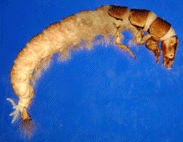

Caddisflies may be the most marvelous of all the aquatic invertebrates, because in addition to being bugs, they are architects!
Most caddisflie larvae live in houses, called cases, that they make themselves. They spin out silk, and either live in silk nets or use the silk to stick together bits of whatever is lying on the stream bottom. These houses are so specialized, that you can almost always identify a caddisfly larva to genus if you can see its case. This is a good thing, because there are over 1,359 species of caddisflies in North America above the Rio Grande River alone!
Caddisflies belong to the order Trichoptera, and are closely related to butterflies and moths, in the order Lepidoptera. They live in most freshwater habitats, from lakes to marshes to rivers, and that is why they are so diverse (have so many species). Each species has special adaptations that allow it to live in the environment it is found in.
Most of the caddisflies are herbivorous--that is, they eat decaying plant tissue and algae. Their favorite algae is diatoms, which they scrape off of rocks. Some of them, though, are predacious: they eat other animals.
Caddisfly larvae can take a year or two to change into adults. They then change into pupae while still inside their cases for their metamorphosis. Caddisflies, unlike stoneflies and mayflies, go through a complete metamorphosis.
They remain as pupae for 2-3 weeks, then emerge as adults. When they leave their pupae, splitting their case, they must swim to the surface of the water to escape it. The winged adults fly evening and night, and some are known to feed on plant nectar. Most of them will live less than a month: like many other winged adults of the stream, their adult lives are brief compared to the time they spend in the water as larvae.





Caddisflies are sometimes grouped by the kinds of cases they make into 5 main groups: free-living forms that don't make cases, saddle-case makers, purse-case makers, net-spinners and retreat-makers, and tube-case makers. Most of the pictures above are of "tube cases," although one of them, the one that looks like a dome of pebbles, is a "saddle case."
As you can see from the pictures, a caddisfly might make a perfect, 4-sided boxy case of bits of leaves and bark, or tiny bits of twigs. It may make a clumsy dome of large pebbles, like the third one on the right, top row. This caddisfly gets its fresh water, and so its oxgen, from water that rushes through the gaps between the pebbles. Others make rounded tubes out of twigs or very small pebbles. When you pluck a caddisfly case out of a mountain river, you may see that it has constructed its case of bits of ordinary rock mixed in with sparkling quartz and red garnet, green peridot, and bright fool's gold.
 Caddisflies in cases have an advantage besides the protection their houses give them. The cases
actually help them breathe. They move their bodies up and down, back and forth inside their cases,
and this makes a current that brings them fresh oxygen. The less oxygen there is in the water, the
faster they have to move. It has been seen that caddisflies inside their cases get more oxygen than
those that are outside of their cases--and this is why scientists think that caddisflies can often
be found even in still waters, where dissolved oxygen is low, in contrast to stoneflies and mayflies.
Caddisflies in cases have an advantage besides the protection their houses give them. The cases
actually help them breathe. They move their bodies up and down, back and forth inside their cases,
and this makes a current that brings them fresh oxygen. The less oxygen there is in the water, the
faster they have to move. It has been seen that caddisflies inside their cases get more oxygen than
those that are outside of their cases--and this is why scientists think that caddisflies can often
be found even in still waters, where dissolved oxygen is low, in contrast to stoneflies and mayflies.
 Key to Macroinvertebrate Life (chart developed by Univ. of Wisconsin-Extension)
Key to Macroinvertebrate Life (chart developed by Univ. of Wisconsin-Extension)
To learn more about macroinvertebrates, check out the reading list, where you will find some excellent references listed. (You will be able to order them from here, too).
 Go back to Aquatic Invertebrates
Go back to Aquatic Invertebrates

| Site Search |
Incomplete metamorphosis is when an animal--an insect or a crustacean (like a crab)-- keeps close to the same body shape and form all the while it is growing up, like you and i do. The problem with this is that insects and crustaceans have exoskeletons (hard shells of a polysaccharide covering them), and exoskeletons don't grow! Instead, at a number of periods as they are growing up, they shed the whole exoskeleton. This is called ecdysis, or molting. While they are still soft and unprotected, they grow as fast as they can--and then they grow a new, bigger exoskeleton. Streams are littered with cast-off exoskeletons, which look exactly like the insect but are empty, and we call these exuviae (egg-zoo-via). We call the young of insects that are growing like this, nymphs. In streams, mayflies and stoneflies both go through incomplete metamorphosis. Each stage of nymph tends to be an identifiable size, and so we call them, depending on their size, "first instar," "second instar," and so on until they turn into imagoes. A typical aquatic insect may go through seven instars.